4 min read
Connext 7.0: New Early Access Release Elevates Scalability, Cybersecurity
 Juhi Ranjan
:
October 4, 2022
Juhi Ranjan
:
October 4, 2022
5 min read
There is a continuing evolution in the autonomy of systems, as they are able to do things humans can't or shouldn't do, but better. While autonomy in systems is on the rise, designing autonomous systems does present unique challenges. Autonomous systems components must operate in environments that are not planned for or expected, such as wide-area networks (WANs). As a result, the boundary between what a human does and what an autonomous system does during operations may suddenly and repeatedly shift during a mission. These systems may therefore need dynamic functional allocations between humans and the autonomous components, as well as between different autonomous components. This results in two key needs from a communications and connectivity point of view:
- Allowing components to organize and operate in smaller subsystems and be able to join and leave a subsystem dynamically
- Enabling components to quickly detect new components as they join or leave a subsystem for low-latency communications
This is the thinking behind the latest version of RTI Connext®, which provides a software-based solution for today's most difficult data connectivity challenges. The new Connext 7.0 release allows intelligent systems to securely accommodate the shifts between autonomous behavior and operator control, and to scale to meet the frequent system modifications and evolving communication requirements. In addition, new features increase the productivity of system development by reducing the time and effort it takes to manage complex systems.
Because RTI is committed to providing releases that meet customer needs at their particular stage of development, we have just introduced two new release tracks that give our customers two ways to optimize their development lifecycle:
- Feature releases - Frequent feature delivery for customers in the development stage of their systems (supported for 7 months)
- Long Term Support (LTS) releases -Highly stable releases for customers who are already in production; supported and maintained for 7 years under standard support. (For more information, visit the Connext Releases & LTS page)
The Early Access Release (EAR) of RTI Connext 7.0 marks the first Feature release of our new model, giving developers access to the latest innovative technology from RTI for achieving real-time connectivity and developing for unknown and unpredictable environments.
In the rest of this blog, I would like to introduce some of the next-generation scalability and cybersecurity features that are available now in the Connext 7.0 EAR release. Developer productivity is also improved with new features in Connext 7.0. After reading further about our new features and benefits, you can instantly download Connext 7.0 EAR* and try out these features in real time! Feel free to reach out to your account teams to learn more.
*Please note that Connext 7.0 is an Early Access Release which is intended to give our customers access to new features, but should not be deployed in production.
SCALABILITY
1. Support communications between dynamic groups of components using Participant Partitions
Now you can architect and dynamically create subsystems of components that interact with each other while remaining isolated from the chatter of other subsystems. The components can migrate from one group to another in an efficient and scalable manner using the new Participant Partitions.
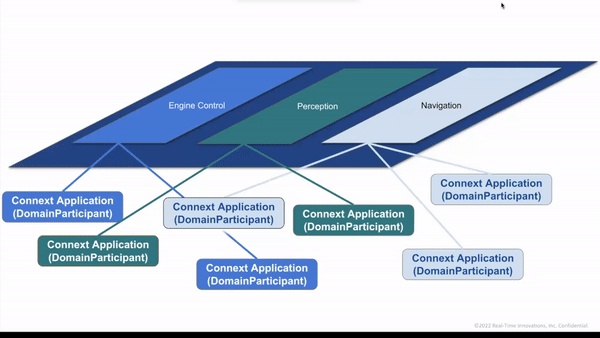
Partitioning at the application level can help reduce network, CPU and memory utilization. This can be particularly useful in large distributed systems or systems that are geographically dispersed (with thousands of participants) in which not all participants need to know about each other at any given time.
Learn more about Participant Partitions
2. Dynamically discover other components with low overhead using the new Simple Participant Discovery Protocol 2.0 (Experimental)
In unicast and wide-area network (WAN) environments, Connext applications can now use dynamic discovery to discover each other in a plug-and-play manner with a much-reduced steady state traffic overhead using the new Simple Participant Discovery Protocol 2.0 (SPDP 2.0).
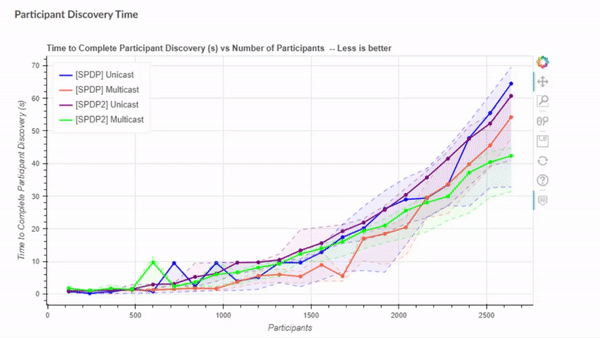
SPDP 2.0 option improves scalability over Simple Participant Discovery by only sending the minimum information in messages to determine matches between participants and to maintain liveliness with participants.
Learn more about Simple Participant Discovery 2.0 (Experimental)
SECURITY
1. Manage authenticated applications dynamically by seamlessly regenerating and redistributing keys
Security Plugins now support a mechanism to securely remove authorized applications from a system at runtime, without needing to recreate the involved applications or lose liveliness. Future releases will add additional ways to trigger key regeneration and redistribution.
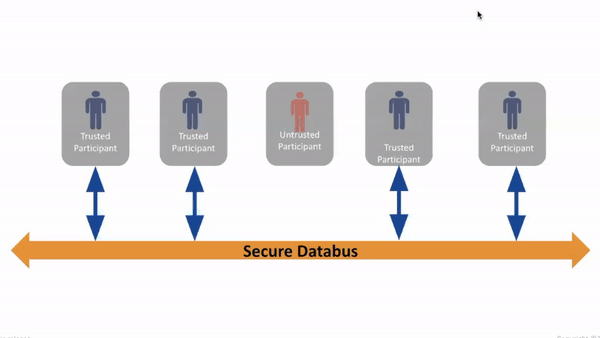
Learn more about Symmetric Key Regeneration and Redistribution
DEVELOPER PRODUCTIVITY
1. Develop Connext applications more easily with the Python API’s support for code generation and user types
This release includes a major update for the experimental Connext Python API (Note: this API shouldn’t be confused with Connector for Python; this is a full Connext API). Connext 7.0 adds support for publishing and subscribing to user data types. These data types can be generated from IDL, XML and XSD, or they can be defined in the user application as decorated dataclasses.
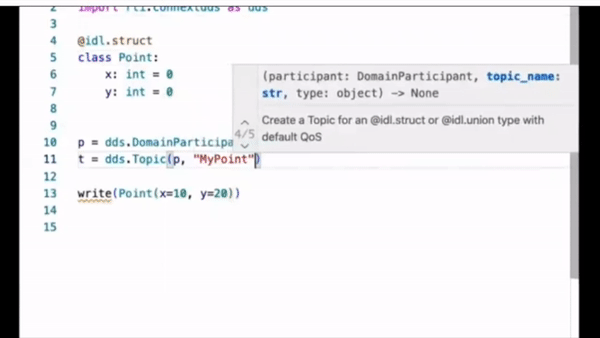
Learn more about Python API (Experimental)
2. Troubleshoot Connext applications from the terminal using simplified DDS Spy output and filter options
RTI DDS Spy's output format has been improved and simplified. There are now two options to display the sample: PLAIN or COMPACT. DDS Spy now also provides you the choice of printing discovery data, user data or everything (Connext 7.0 is based on the Data Distribution Service (DDS™) standard).
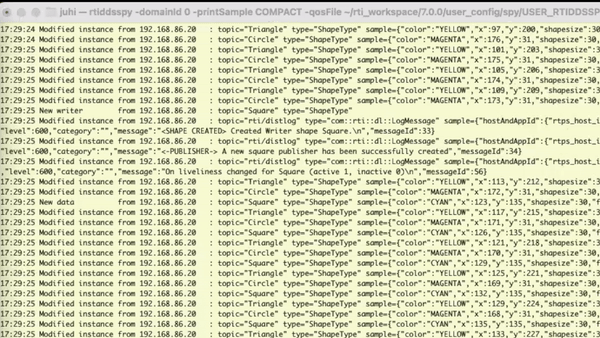
DDS Spy’s new simplified output is easy to export and visualize with Excel or Google Sheets
Learn more about new features in DDS Spy
CONCLUSION
By now, we hope you’re eager to get your hands on the latest and greatest from RTI. So let’s get you started! You can learn more and download Connext 7.0 at the following links:
- Visit RTI’s Support Portal to download Connext 7.0
- Visit What’s New for a complete list of the new features
- Visit Migrating to Connext 7.0 for guidance on adopting the new version
About the author
 Juhi Ranjan is the Group Product Manager at RTI, responsible for aligning market needs with RTI's flagship products. She is responsible for all aspects of the product strategy for Connext Professional, from conception to launch. Additionally, she oversees a team of product managers at RTI who are responsible for driving product initiatives.
Juhi Ranjan is the Group Product Manager at RTI, responsible for aligning market needs with RTI's flagship products. She is responsible for all aspects of the product strategy for Connext Professional, from conception to launch. Additionally, she oversees a team of product managers at RTI who are responsible for driving product initiatives.
Posts by Tag
- Developers/Engineer (180)
- Technology (79)
- Connext Suite (77)
- News & Events (75)
- 2020 (54)
- Aerospace & Defense (52)
- Standards & Consortia (51)
- Automotive (38)
- 2023 (34)
- 2022 (29)
- IIoT (27)
- 2025 (25)
- Leadership (24)
- Healthcare (23)
- 2024 (22)
- Connectivity Technology (21)
- Cybersecurity (20)
- 2021 (18)
- Culture & Careers (15)
- Military Avionics (15)
- FACE (13)
- Connext Pro (10)
- JADC2 (10)
- ROS 2 (10)
- Connext Tools (7)
- Connext Micro (6)
- Databus (6)
- Transportation (5)
- Case + Code (4)
- Connext (4)
- Connext Cert (4)
- Energy Systems (4)
- FACE Technical Standard (4)
- AI (3)
- Oil & Gas (3)
- Research (3)
- Robotics (3)
- #A&D (2)
- Connext Conference (2)
- Edge Computing (2)
- Golden Dome (2)
- MDO (2)
- MS&T (2)
- RTI Labs (2)
- TSN (2)
- ABMS (1)
- C4ISR (1)
- DOD (1)
- ISO 26262 (1)
- L3Harris (1)
- LabView (1)
- MOSA (1)
- MathWorks (1)
- National Instruments (1)
- Simulation (1)
- Tech Talks (1)
- UAM (1)
- Videos (1)
- eVTOL (1)
 Success-Plan Services
Success-Plan Services